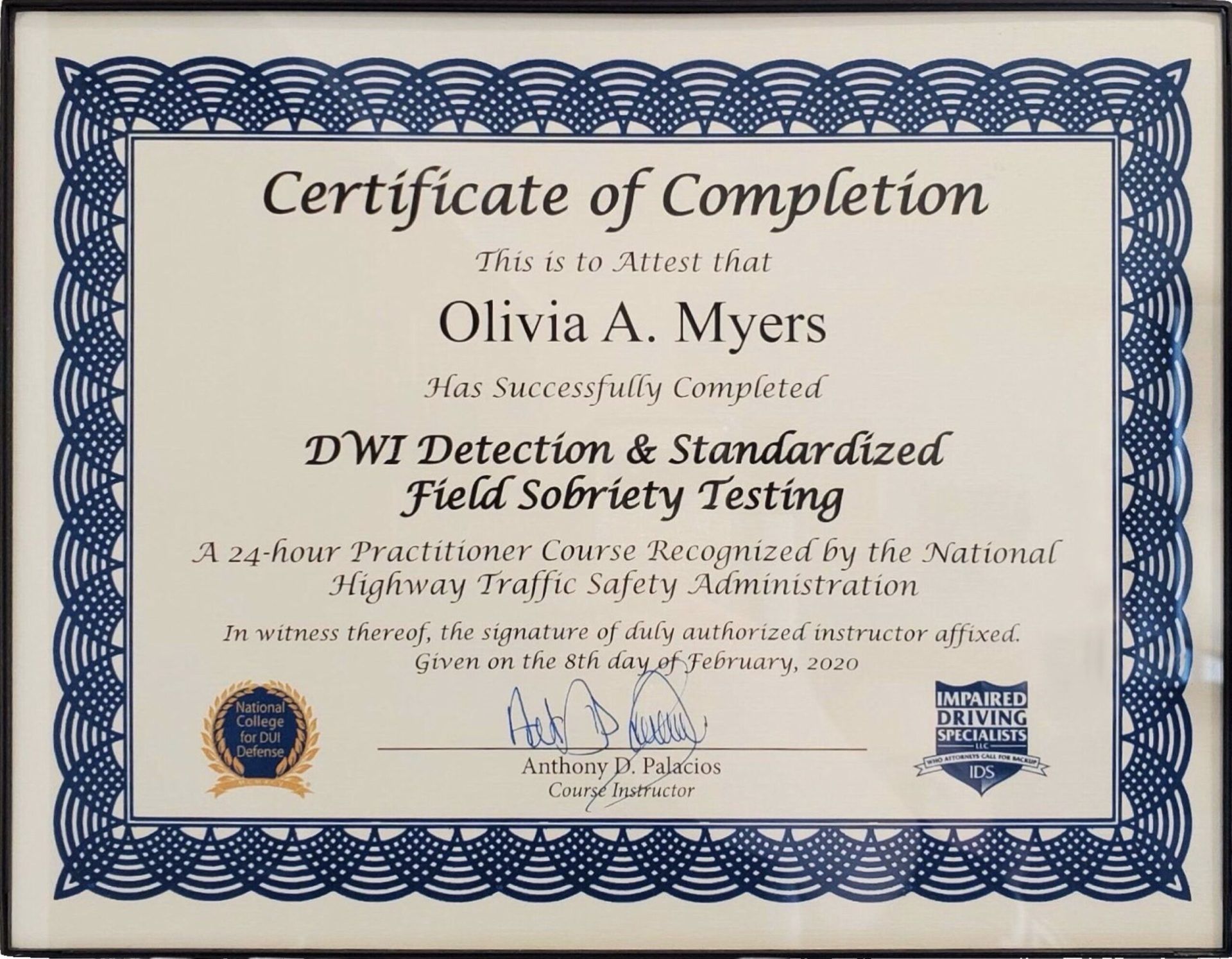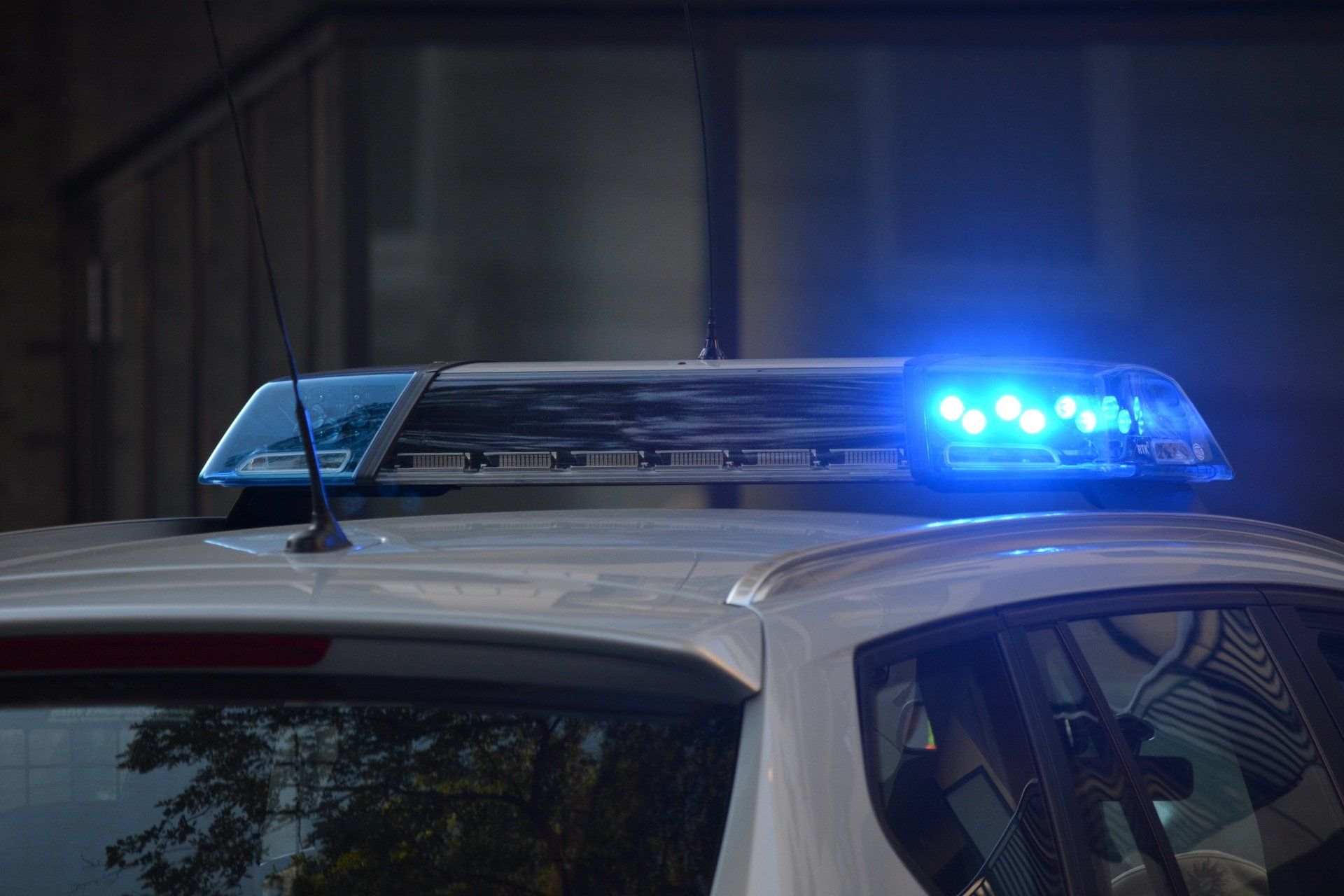
Available 24/7
OVI AND DUI SERVICES
EXTENSIVE DUI TRAINING
OVI AND DUI
PROTECTING YOUR RIGHTS
Attorney Olivia Myers forcefully defends against OVI charges. When it comes to an administrative license suspension O. Myers Law will:
- Ensure all of the legal procedures are followed exhaustively
- Find legal issues in your case and challenge the charges in order to get you the best resolution possible
- Question whether the police:
- had probable cause to stop you
- had a reasonable, articulable suspicion that you were intoxicated
- administered the field sobriety tests in accordance with the National Highway Traffic Safety Administration
- Administered the breath test according to the Ohio Department of Health regulations and whether that reading was scientifically accurate
OVI & DUI Frequently Asked Questions
-
What is the difference between OVI and DUI?
The law loves acronyms, whether you have been given a ticket, that has “DUI”, “OVI”, “DWI” or “OMVI” – they all mean the same thing, that you have been charged with a serious traffic offense of Operating a Motor Vehicle While Under the Influence of Drugs or Alcohol.
-
What does the State have to prove for an OVI/DUI?
1. A person operated a vehicle
The Supreme Court of Ohio has said, "Operation of a motor vehicle within contemplation of the statute is a broader term than mere driving and a person in the driver's position in the front seat with the ignition key in his possession indicating either his actual or potential movement of the vehicle while under the influence of alcohol or any drug of abuse can be found in violation of the DUI statute.
Subsequently, the Court expanded the definition of "operate" to include situations where the keys were in the ignition but the engine was not running.
The Court has gone on to hold that the term 'operate' is still broad enough to encompass an impaired passenger who grabs the steering wheel of a moving vehicle * * * but an impaired passenger cannot be convicted of a physical control violation because he is not in the driver's seat."
In State v. Wallace, the appellate court for Hamilton County held that even a passenger could be charged with DUI, when it held: "Wallace's conduct caused movement of the vehicle and the driver's loss of control when she grabbed the steering wheel and caused the vehicle to crash. Accordingly, her conduct fit within the unambiguous statutory definition of 'operate' in R.C. 4511.01(HHH)."
Further, the law encompasses the concept of being in “physical control” of the vehicle. As the Eighth Appellate District has held: “…if there is no evidence that the person moved or caused the vehicle to move, that person cannot be convicted of OVI, but may be convicted of being in physical control of a vehicle while under the influence. Still, a person who is found passed out in his vehicle on the side of the highway may be convicted of an OVI because a jury could infer that the vehicle was moved to that location. However, if a person decides to 'sleep it off" in the parking lot of the bar where the person drank, the person could be convicted only of a physical control violation, unless there is evidence of movement." State v. Schultz, 2008-Ohio-4448, 2008 Ohio App. LEXIS 3753 (8th Dist.) cited with approval in State v. Justus, 2009-Ohio-137, P11, 2009 Ohio App. LEXIS 146, *5-6, 2009 WL 98445 (8th Dist.)’
The lesson from these cases is that whether you were the driver or the passenger or “sleeping it off” on the side of the road, in a vehicle with the keys within your reach, you can and will be charged with DUI. The DUI statute is going to apply to you. And you are going to need Attorney Meyers to represent you against the State.
2. A person is under the influence of alcohol and/or drugs of abuse
There are two ways that a person can be found to be “under the influence” under Ohio law.
A per se OVI: In Ohio, it is per se (“by itself”) illegal to operate a vehicle with a prohibited concentration of alcohol and/or drugs in the driver’s breath, blood or urine. If a driver’s alcohol or drug level is ‘over the limit’ while operating a vehicle, the driver is guilty of DUI / OVI ‘Per Se’, even if the alcohol and/or drug(s) did not impair the driver’s ability to operate the vehicle. The Ohio prohibited concentrations include the following:
Alcohol
- Breath: .08%
- Whole blood: .08%.
- Blood Serum or Plasma: .096%
- Urine: .11g
Amphetamine: 500 ng urine, 100 ng whole blood, blood serum, or plasma,
Cocaine: 150 ng, 50ng whole blood, blood serum, or plasma
Cocaine Metabolite: 150 mg, 50 ng whole blood, blood serum, or plasma
Heroin: 2000 ng, 50 ng whole blood, blood serum, or plasma
Heroin Metabolite: 10 ng, 10 ng whole blood, blood serum, or plasma
L.S.D.: 25 ng, 10 ng whole blood, blood serum, or plasma
Marihuana: 10 ng, 2 ng whole blood, blood serum, or plasma
Marihuana Metabolite and Under the influence: 35 ng, 5 ng whole blood, blood serum, or plasma
Marihuana Metabolite: 35 ng, 50 ng whole blood, blood serum, or plasma
Methamphetamine: 500 ng, 100 ng whole blood, blood serum, or plasma
Phencyclidine: 25 ng, 10 ng whole blood, blood serum, or plasma
No test but under the influence: if a person refuses a blood, breath, or urine test, the officer can still charge that person with OVI/DUI if the officer believes the person is impaired. The definition of impairment under Ohio law requires that the State prove the person’s actions, reactions, and mental processes demonstrate that the person is under the influence of alcohol and/or drugs.
-
What should you do if you get pulled over?
If you get pulled over by the police, here are some guidelines to keep in mind:
1. Look for a safe place to pull over. If you’re on a highway, pull over to the
shoulder.
2. Once you have pulled over, do not get out of your vehicle, turn off your engine
and roll down your driver’s side window. Keep your hands visible on the steering wheel.
3. Wait for instructions from the police officer: Wait for the officer to approach your vehicle and ask for your license, registration, and proof of insurance. Be polite and respectful.
4. Avoid arguing or being confrontational with the officer. If you disagree with
the ticket or citation, you can dispute it in traffic court.
5. An officer who stops you for an alleged traffic violation has the right to insist that you and your passengers get out of your car. See Pennsylvania v. Mimms, 434 U.S. 106 (1977); Maryland v. Wilson, 519 U.S. 408 (1997) You should listen to what
the officer asks you, be responsive and polite, do not volunteer information. Do
not get out of your vehicle and start arguing with the police officer
-
What evidence will the police attempt to gather at the time of the traffic stop?
In State v. Schmitt, 101 Ohio St.3d 79, 2004 Ohio 37, 801 N.E.2d 446, the question presented was whether an officer's observations may be admitted regarding a Defendant's performance of nonscientific standardized field sobriety tests when those tests are not administered in substantial compliance with NHTSA Guidelines?
The Supreme Court of Ohio held that an officer's observations regarding a defendant's performance on nonscientific field sobriety tests is admissible as lay evidence of intoxication. "The manner in which a defendant performs these tests may easily reveal to the average lay person whether the individual is intoxicated." Id. at P14. The Supreme Court reasoned, we “see no reason to treat an officer's testimony regarding the defendant's performance on a nonscientific field sobriety test any differently from his testimony addressing other indicia of intoxication, such as slurred speech, bloodshot eyes, and odor of alcohol." Id.
The High Court further reasoned, unlike “actual test results, which may be tainted, the officer's testimony is based upon his or her firsthand observation of the defendant's conduct and appearance. Such testimony is being offered to assist the judge or jury in determining a fact in issue, i.e., whether a defendant was driving while intoxicated. Moreover, defense counsel has the opportunity to cross-examine the officer to point out any inaccuracies and weaknesses. We conclude that an officer's observations in these circumstances are permissible lay testimony under Evid.R. 701. ***" Id. at P15. In the case sub judice, even assuming Officer Erskine did not substantially comply with NHTSA standards, and the test results of the field sobriety tests had to be excluded (only the walk-and-turn test and the one-leg balance tests are recognized by NHTSA), his observations regarding Green's performance of these tests, as well as the alphabet recitation test, were admissible and could be considered by the trier of fact. State v. Green, 2007-Ohio-1713, P48-P50, 2007 Ohio App. LEXIS 1573, *16-18 (8th Dist.)
The trial court will look at various factors to determine whether the police had a reasonable, articulable suspicion for pulling you over, and whether there was probable cause to believe that a DUI/OVI offense had been committed. The Evans factors for determining whether a reasonable, articulable suspicion existed for the officer to believe defendant was impaired and in requesting defendant to perform field sobriety tests include, but are not limited to: (1) time and day of the stop; (2) the location of the stop; (3) erratic driving that shows lack of coordination; (4) a cognizable report that the driver is intoxicated; (5) condition of the suspect's eyes; (6) speech impairments; (7) odor of alcohol from the interior of the car or the suspect's breath; (8) the intensity of the odor; (9) the suspect's demeanor; (10) actions that indicate a lack of coordination; and (11) an admission of alcohol consumption. Evans, 127 Ohio App.3d at 63, fn. 2, cited with approval in City of Findlay v. Jackson, 2014-Ohio-5202, P1, 2014 Ohio App. LEXIS 5063, *1
The arresting officer's experience in dealing with drunk drivers can also be taken into account. Id.
In Ohio, a warrantless arrest in operating a motor vehicle while intoxicated case is constitutional so long as, at that moment, the officer had probable cause to make the arrest. State v. Woodards (1966), 6 Ohio St.2d 14, 215 N.E.2d 568. For the results of a field sobriety test to serve as evidence of probable cause to arrest, the police must have administered the test in substantial compliance, rather than strict compliance, with standardized testing procedures. R.C. 4511.19; R.C. 4511.19; State v. Schmitt, 101 Ohio St.3d 79, 82, 2004 Ohio 37, 801 N.E.2d 446; see City of Strongsville v. Troutman, 2007-Ohio-1310, P22, 2007 Ohio App. LEXIS 1201, *9-10 (8th Dist.).
-
What are roadside sobriety tests and what happens if I refuse to do the tests?
The police will request that you perform roadside sobriety tests as a part of their evidence, which they intend to use against you. Roadside sobriety tests, also known as field sobriety tests, are a series of standardized exercises that police use to assess your level of impairment. The standardized roadside sobriety tests include:
• Horizontal Gaze Nystagmus (HGN) Test: This test involves an officer asking the driver to follow a pen or other object with their eyes while the officer checks for involuntary jerking of the eyes, which can be more pronounced when a person is impaired.
• Walk-and-Turn Test: In this test, the driver is asked to take a certain number of steps in a straight line, heel-to-toe, and then turn and take the same number of steps back. Officers look for signs of balance and coordination impairment.
• One-Leg Stand Test: The driver is asked to stand on one leg and count aloud for a specified duration, while the officer observes you for swaying, hopping, or loss of balance.
There are also Non-Standardized or Non-Scientific Field Sobriety Tests (NSFTs), which the police will occasionally use, including, inter alia., the following:
• Finger-to-Nose Test: In this test, the driver is instructed to touch their nose with the tip of their finger while standing with their eyes closed. The officer assesses the driver's ability to perform this task accurately.
• Alphabet or Counting Backwards: Sometimes, officers may ask the driver to recite the alphabet or count backwards to assess their cognitive functioning.
• Modified Romberg Balance Test: This test requires the driver to estimate the passage of 30 seconds with their eyes closed while standing with their feet together and their head tilted back.
If you refuse to participate in or complete these roadside sobriety tests and/or refuse to take the Breathalyzer test, it is typically referred to as a "refusal." A refusal can have legal consequences, as Ohio has an implied consent law. This means that by obtaining a driver's license in the state, you agree to submit to chemical tests (usually breath, blood, or urine tests) if a law enforcement officer has reasonable grounds to believe you are operating a vehicle under the influence. Refusing these chemical tests can result in penalties, including the suspension of your driver's license and other consequences. The Breathalyzer test, or similar breath alcohol testing devices, measure a person's blood alcohol concentration (BAC) when there is suspicion of DUI/OVI.
The Breathalyzer test is a device that measures the concentration of alcohol in a person's breath, which is then used to estimate their BAC. The police may use different devices to measure the alcohol content of your breath, including the following:
• Preliminary Breath Test or Portable Breath Test (PBT): If the police stop a driver and have a “reasonable suspicion” that the driver may be under the influence of alcohol or drugs, they may administer a Preliminary Breath Test (PBT) using a portable breath testing device. This is typically done at the roadside. The results of this test can help the officer establish probable cause for an arrest.
• Intoxilyzer 8000/DataMaster: After an arrest for suspected DUI/OVI, the driver is usually taken to a police station, sheriff's office, or other authorized facility for further testing. In Ohio, the commonly used breath testing devices are the Intoxilyzer 8000 or the DataMaster. These machines are used to obtain a more accurate and precise BAC reading than the PBT. The driver is asked to blow into the machine, and it analyzes the breath sample to estimate the BAC.
-
What are the penalties if you refuse to take the Breathalyzer test?
In Ohio, when a person suspected of driving under the influence (DUI or OVI - Operating a Vehicle Impaired) refuses to submit to a chemical test (typically a breath, blood, or urine test) to determine their blood alcohol concentration (BAC), they can face administrative penalties in addition to any criminal penalties for DUI/OVI if convicted. These administrative penalties are related to the refusal itself and are imposed by the Ohio Bureau of Motor Vehicles (BMV), not the criminal court. Keep in mind that the specific penalties may vary depending on the circumstances and any prior refusal or DUI/OVI convictions.
First Refusal:
License Suspension: A first refusal typically results in a one-year driver's license suspension.
Second Refusal within 10 Years:
License Suspension: A second refusal within 10 years of a prior refusal or OVI conviction may lead to a two-year driver's license suspension.
Third and Subsequent Refusals within 10 Years:
License Suspension: A third or subsequent refusal within 10 years of prior refusals or OVI convictions can result in a three-year driver's license suspension.
You should be aware that these administrative penalties for refusal are separate from and, in addition to, the criminal penalties, you will face if you are convicted of DUI/OVI by a judge or by a jury. Attorney Olivia Myers can provide you with aggressive representation against the State, who often seek the maximum penalties for DUI/OVI offenders.
-
What are the penalties for DUI/OVI?
Ohio has specific penalties for DUI (Driving Under the Influence)/ OVI (Operating a Vehicle While Impaired). These penalties can vary depending on factors such as the driver's blood alcohol concentration (BAC), any prior DUI/OVI convictions, and other circumstances surrounding the offense. The penalties for OVI offenses include mandatory minimums, which means the judge has no discretion in sentencing. This is why it is so imperative to litigate all aspects of your case and explore the options for a dismissal or a reduced charge through Attorney Olivia Myers.
First OVI/DUI Offense in 10 years:
Misdemeanor of the first degree
3 days jail or 3 day Driver Intervention Program (“DIP”): 72 hour lockdown course
$375-$1,075 fine
1-3 year license suspension
Treatment Optional
Driving Privileges: Must wait 15 days from the date of the offense
First OVI/DUI Offense in 10 years and either: a) High test or b) Refusal with prior in 20 years
Misdemeanor of the first degree
6 days jail or 3 days jail and 3 days DIP
$375-$1,075 fine
1-3 year license suspension
Treatment Optional
Driving Privileges: Must wait 15 days from the date of the offense
Second OVI/DUI Offense in 10 years (simple OVI, low test or drug)
Misdemeanor of the first degree
License Suspension: A second offense results in a license suspension of one to seven years. The courts can require plates and Interlock devise if you are granted driving privileges.
Fine: The fine can range from $525 to $1,625.
Mandatory Alcohol/Drug Assessment and Treatment if Recommended.
90 day immobilization of vehicle (boot on vehicle) if registered to Defendant.
Jail Time: A mandatory minimum of 10 consecutive days in jail, or 20 days in jail if you blew high (.17 or above) or if you refused a breath test and have a prior refusal within 20 years, up to a maximum of 180 days.
Third Offense DUI/OVI (within 10 years):
Unclassified Misdemeanor
License Suspension: A third offense results in a license suspension of two to 12 years. The courts can require plates and Interlock devise if you are granted driving privileges.
Fine: The fine can range from $850 to $2,750.
Mandatory Alcohol/Drug Addiction Program
Forfeiture of the vehicle if registered to Defendant
Jail Time: A mandatory minimum of 30 consecutive days in jail, or 60 days in jail if you blew high (.17 or above) or if you refused a breath test and have a prior refusal within 20 years, up to a maximum of one year.
Felony DUI/OVI:
If you have a history of multiple DUI/OVI offenses within a specified timeframe, you can be charged with a felony, which can result in more severe penalties, including a prison sentence.
Penalties may include:
• A mandatory local incarceration or prison
• A fine of up to $10,500.
• License suspension of three years to life. The courts can require plates and Interlock devise if you are granted driving privileges.
• Mandatory completion of a drug or alcohol treatment program.
• Forfeiture of the vehicle if registered to Defendant
• Probation.
Please be advised that these penalties can change over time due to legislative updates or changes in Ohio's DUI/OVI laws. Additionally, other factors such as the presence of minors in the vehicle or causing serious accidents with injuries or fatalities can lead to more severe penalties. It is crucial to consult with Attorney Myers for legal representation and guidance if you are facing DUI/OVI charges in Ohio.
-
What is an ALS Suspension?
An Administrative License Suspension is an administrative license suspension processed the Bureau of Motor Vehicles. It is separate and distinct from the penalties, which you may face from the trial court. If an ALS suspension is entered against you, it is imperative to hire an OVI Attorney to appeal it, which is separate and distinct from the criminal case. State v. Gustafson, 76 Ohio St.3d 425, 1996 Ohio 299, 668 N.E.2d 435 (1996), paragraph two of the syllabus;
Attorney Myers can assist you in navigating through this difficult administrative aspect of a DUI/OVI case.
-
What if you under 21 years of age, and are charged with Underage DUI/OVI ?
In Ohio, underage OVI/DUIs are referred to as Operating a Vehicle Under the Age of Consumption (“OVUAC”). This is a separate section of ORC. 4511.19 that the officer must charge under. If you are charged with Underage DUI/OVI, the legal BAC limit for drivers for underage drivers is currently 0.02% BAC. This means that even a very small amount of alcohol in your system can result in a conviction for Underage DUI/OVI. In Ohio,
A BAC of .02 or higher, however, is not required for a person under the age of 21 to be charged with a DUI/OVI. In Ohio, it is per se (“by itself”) illegal to operate a vehicle with a prohibited concentration of alcohol and/or drugs in the driver’s breath, blood or urine. If a driver’s alcohol or drug level is ‘over the limit’ while operating a vehicle, the driver is guilty of DUI / OVI ‘Per Se’, even if the alcohol and/or drug(s) did not impair the driver’s ability to operate the vehicle.
Finally, if a person under the age of 21 refuses a blood, breath, or urine test, the officer can still charge that person with OVI/DUI if the officer believes the person is impaired. The definition of impairment under Ohio law requires that the State prove the person’s actions, reactions, and mental processes demonstrate that the person is under the influence of alcohol and/or drugs.
-
What are the penalties for Underage OVI in Ohio?
The penalties for underage drinking and driving in Ohio can include the following:
First OVUAC Offense in one year: A first offense is a misdemeanor of the fourth degree, which means it carries a maximum penalty of 30 days in jail and a $250 fine. It carries a license suspension for a period of 90 days to 2 years. The underage driver must also wait 90 days hard time before the court can grant driving privileges. The lookback period for whether someone has a prior OVUAC is only one year.
Second OVUAC Offense in one year: A second offense within one year is a misdemeanor of the third degree, which means it carries a maximum penalty of 60 days in jail and a $500 fine. It carries a license suspension for a period of 1 to 5 years. The underage driver must also wait 90 days hard time before the court can grant driving privileges. The lookback period for whether someone has a prior OVUAC is only one year.
Mandatory Alcohol Education Programs: The Ohio BMV often requires underage OVI offenders to retake the driver’s exam and take an additional juvenile driving course.
Probation:Offenders may be placed on probation and subject to various probation conditions.
Criminal Record: An underage OVI conviction can result in a criminal record, which can have long-term consequences for employment and other aspects of life.
Aggravated Vehicular Homicide or Assault (Felony of the Second Degree):
If a DUI/OVI offense leads to the death or serious injury of another person, it can result in charges of aggravated vehicular homicide or assault, which is a felony of the second degree.
Penalties may include:
• Significant prison sentences, often ranging from 2 to 8 years or more, depending on the circumstances.
• A fine of up to $15,000.
• License suspension.
• Mandatory completion of a drug or alcohol treatment program.
• Possible vehicle forfeiture.
• Ignition Interlock Device (IID) installation.
• Probation.
-
What are the possible defenses to a DUI/OVI charge in Ohio?
Defending against a DUI (Driving Under the Influence) or OVI (Operating a Vehicle Impaired) charge in Ohio can be complex, and the strategies used will depend on the specific circumstances of your case. It's essential to consult with Attorney Myers to assess your options and build a strong defense. However, here are some possible defenses that may be used in DUI/OVI cases in Ohio:
• Challenging the Traffic Stop: You may challenge the legality of the traffic stop that led to your arrest. If law enforcement did not have a valid reason to stop your vehicle, any evidence obtained after the stop may be suppressed.
• Challenging the Field Sobriety Tests: Field sobriety tests (FSTs) are subjective assessments of a driver's coordination and balance. You may challenge the accuracy and reliability of these tests, arguing that other factors (fatigue, medical conditions, etc.) affected your performance.
• Challenging the Breathalyzer or Blood Test Results: You may question the accuracy and reliability of the chemical test results, such as the Breathalyzer or blood test. This can involve challenging the maintenance and calibration of testing equipment or the qualifications of the person administering the test.
• Chain of Custody Issues: If blood samples were taken, you may challenge whether proper procedures were followed to maintain the chain of custody. Breaks in the chain of custody can raise doubts about the integrity of the blood sample.
• Rising Blood Alcohol Defense: This defense argues that your BAC was below the legal limit at the time of driving but rose to an illegal level by the time the test was administered. This can be a complex defense that requires expert testimony.
• Medical Conditions or Medication: If you have a medical condition or were taking prescription medication, your attorney may argue that these factors contributed to the appearance of impairment or elevated BAC levels.
• No Actual Physical Control: You may challenge whether you were in "physical control" of a vehicle while impaired. If you were not actually driving or operating the vehicle at the time of arrest.
• Miranda Rights Violation: If the police failed to read you your Miranda rights before questioning you, your attorney may challenge the admissibility of statements you made during the initial detention, seizure and arrest.
• Improper Arrest Procedures: If your arrest procedures did not follow proper protocols, such as failing to provide you with a proper opportunity to contact an attorney, your attorney may challenge the legality of your arrest.
• Witness Credibility: Your attorney may challenge the credibility of the arresting officer or any witnesses involved in your case, casting doubt on the accuracy of their observations or testimony.
The effectiveness of these defenses can vary based on the skills, knowledge and expertise of your lawyer. Further, not all defenses will apply to your case. It's crucial to consult with Attorney, Olivia Myers, a highly qualified, aggressive DUI/OVI attorney who can assess your case, gather evidence, and pursue a vigorous defense to get you the best result for your case.
FREE CONSULTATION
O. MYERS LAW LLC
VIRTUAL LAW OFFICE IS AVAILABLE 24/7
CALL NOW FOR A FREE CONSULTATION→
O. Myers Law wants to defend you in your case!
CONTACT US
Footer Contact Us Form
We will get back to you as soon as possible.
Please try again later.
All Rights Reserved | O. Myers Law LLC | This site is powered by Bluefoot.





